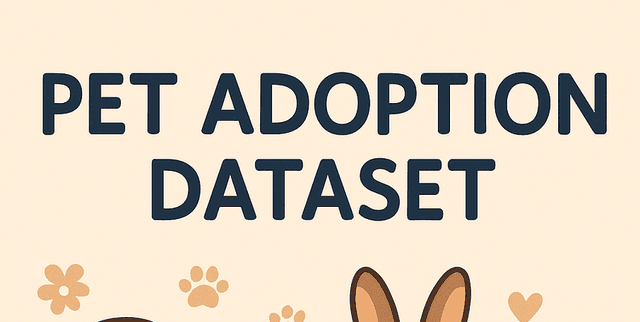Synthetic Pet Adoption Records
Synthetic Data Generation
Tags and Keywords
Trusted By




"No reviews yet"
Free
About
A synthetic collection of 200 detailed records simulating pet adoption scenarios from an adoption centre. The dataset provides extensive details on both the animal—including species, breed, age, and arrival date—and the corresponding adopter demographics, such as age, city, and previous pet ownership history. It is specifically designed to be highly usable, featuring 15 columns with absolutely no missing values, making it an excellent resource for immediate analytical practice.
Columns
- pet_id: Unique identification code assigned to each animal.
- pet_name: The assigned name of the pet.
- species: The type of animal (e.g., Cat, Hamster). There are 5 unique species.
- breed: The specific breed of the animal. There are 58 unique breeds identified.
- age_years: The age of the pet, recorded in years.
- gender: The biological sex of the pet (Female or Male).
- color: The colouration or pattern of the pet (e.g., Spotted, White).
- arrival_date: The date when the pet was brought into the adoption centre.
- adopted: A Boolean flag indicating whether the pet has found a home (True or False). 59% of records show adoption success.
- adoption_date: The date the adoption transaction was finalised.
- adopter_id: Unique identifier for the person adopting the pet. Contains 'N/A' for non-adopted pets.
- adopter_name: The full name of the adopter. Contains 'N/A' for non-adopted pets.
- adopter_age: The age of the adopter. This field uses '-1' as a placeholder if the pet was not adopted.
- adopter_city: The city of residence for the adopter. Contains 'N/A' for non-adopted pets.
- adopter_previous_pets: The count of animals previously adopted by the individual. Contains '0' for non-adopted pets.
Distribution
The data is structured as a single tabular file named
pet_adoption_center.csv. It contains 200 individual records and 15 distinct data fields. The file size is approximately 20.48 kB. A key feature is the high quality and structure, ensuring 100% validity across all columns with zero missing data points.Usage
The data is perfectly suited for exploratory data analysis (EDA), data visualisation projects, and practising predictive modeling techniques. Specific applications include:
- Analysing trends in adoption rates broken down by species, breed, or geographical location.
- Developing models to predict the speed or likelihood of a pet being adopted.
- Visualising and studying the demographic profiles of successful adopters.
- Practising data preprocessing and cleaning skills within a controlled, clean environment.
Coverage
This is a synthetic dataset. The time scope covers a simulated period for pet arrivals ranging from 22 June 2023 to 14 June 2025. Adoption events are simulated between 20 July 2023 and 29 June 2025. Geographic and demographic coverage is modelled to simulate diverse species, various pet ages, and a distribution of adopter profiles, including city and age information.
License
CC0: Public Domain
Who Can Use It
The resource is highly recommended for beginners and intermediate users. It is particularly useful for students learning data science fundamentals, data analysts seeking clean practice data, and developers needing a reliable tabular structure for application testing. Intended users benefit from being able to focus purely on analysis and modeling without initial time spent on extensive missing value imputation.
Dataset Name Suggestions
- Synthetic Pet Adoption Records
- Animal Welfare Data Simulation
- Pet Adoption Success Metrics
- Shelter Outcome Statistics
- Adopter Demographic Analysis
Attributes
Original Data Source: Synthetic Pet Adoption Records
Loading...
